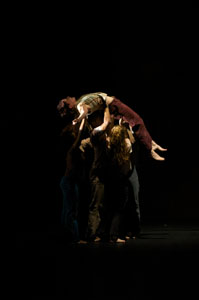12.) EXPLORING CAREERS AND LIFELONG LEARNING
Dancing is for everyone

David Dorfman’s career in dance is unusual in that he didn’t start dancing until he was in college. Perhaps it is because of this belated beginning that compels him to include all kinds of people in his performances. underground uses a group of 20 extra people from the community in several culminating scenes. Dorfman is one of many contemporary choreographers who use non-professional dancers in their works. At the end of the twentieth century, various choreographers and dance companies began to use amateur dancers of all ages, shapes, and sizes to help create a world of dancers onstage that reflected the diversity of people in the audience. These experiments opened up the field of dance considerably. No longer does one have to have the perfect model-thin body in the right proportions to imagine oneself as a dancer. In fact, several companies in the United States and abroad are specifically focused on making dances for disabled dancers, or dancers of mixed abilities. All these egalitarian movements in dance create more and more opportunities for everyone to get involved, regardless of previous experience or training.
Classroom Activity: Who can dance?
Break the students up into three groups and have each group research one of the following dance companies: Liz Lerman’s “Dancers of the Third Age,” Adam Benjamin’s “Candoco,” or “Axis Dance” from San Francisco. Then have the students present to the class the information they have gathered. After all the groups have gone, have the class discuss how these examples might change how they think about which kinds of bodies can be dancing bodies.

